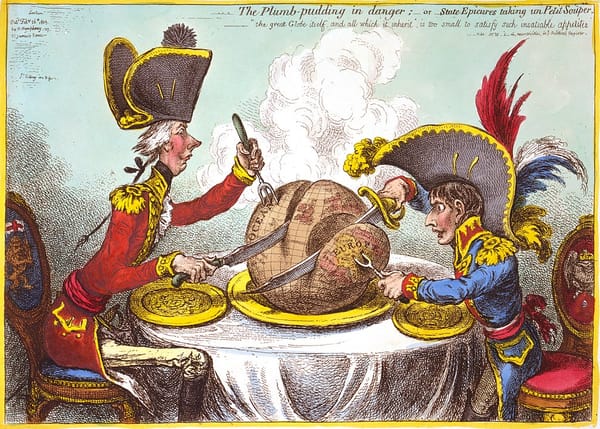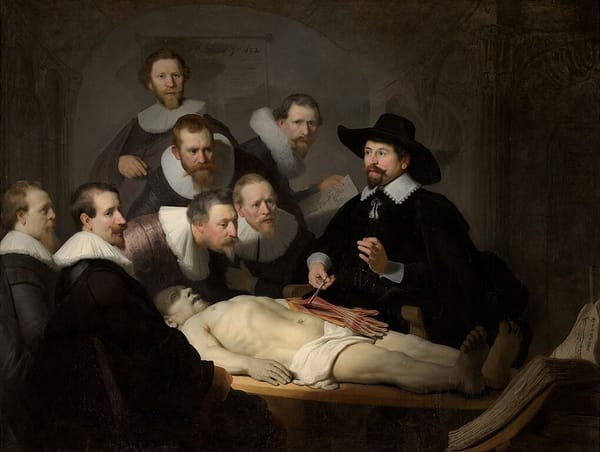The Harmony of Interests

Many liberal theorists have an implied distaste for politics. One prominent type of this liberal anti-politics presupposes a harmony of interests. This is visible, for example, in the following passage in Rawls: “Assume further that expectations are close-knit: that is, it is impossible to raise or lower the expectation of any representative man without raising or lowering the expectation of every other representative man, especially that of the least advantaged.”[1] For Rawls this property of close-knittedness is a claim about how the world could and should be. (He is not presenting it as an empirical claim about existing social institutions.) So, it is natural to read Rawls as claiming that under just social conditions there is a harmony of interests.
Rawls presents this commitment as continuous with the liberal tradition. Here’s an important passage early in A Theory of Justice:
In designing and reforming social arrangements one must, of course, examine the schemes and tactics it allows and the forms of behavior which it tends to encourage. Ideally the rules should be set up so that men are led by their predominant interests to act in ways which further socially desirable ends. The conduct of individuals guided by their rational plans should be coordinated as far as possible to achieve results which although not intended or perhaps even foreseen by them are nevertheless the best ones from the standpoint of social justice. Bentham thinks of this coordination as the artificial identification of interests, Adam Smith as the work of the invisible hand. It is the aim of the ideal legislator in enacting laws and of the moralist in urging their reform.[2]
Rawls is describing his own program when he writes that in designing and reforming those social arrangements which are “the constitutive rules,” which just are (a part of) the basic institutions of society, “the conduct of individuals guided by their rational plans should be coordinated as far as possible to achieve results which although not intended or perhaps even foreseen by them are nevertheless the best ones from the standpoint of social justice.” Rawls’ point is that this coordination of plans is formally equivalent to Bentham’s artificial identification of interests and Smith’s invisible hand.
To be sure, Rawls’ formulation of the harmony of interests doctrine is cautious; Rawls restricts the doctrine to our ‘predominant’ interests, and these, in turn, further our socially desirable ends. But even so, the harmony of interests does play an important role in the structure of key features of Rawls’ set up: when it comes to treating the original position, Rawls allows himself a device of a ‘representative man.’[3] As he puts it: “certain general desires, such as the desire for primary social goods, and by taking as a basis the agreements that would be made in a suitably defined initial situation, we can achieve requisite independence from existing circumstances. The original position is so characterized that unanimity is possible; the deliberations of any one person are typical of all.”[4] That social life can be modelled through something like a representative agent is, of course, not unique to Rawls; in the 1970s economists developed variants of the idea for their own ends.[5]
In the accompanying footnote to the passage from p. 49 of TJ, Rawls claims that “The phrase “the artificial identification of interests” is from Elie Halévy’s account of Bentham.” Rawls cites pp. 20-24 from volume 1 of the French edition. In the English translation this is pp. 15-18 (which basically runs from Mandeville to Helvetius). The key passage is worth quoting:
But there is yet another argument which can be used: while still admitting that individuals are chiefly or even exclusively egoistic, it is yet possible to deny that their egoisms will ever harmonise either immediately or even ultimately. It is therefore argued that in the interest of individuals the interest of the individual must be identified with the general interest, and that it is the business of the legislator to bring about this identification. This may be called the principle of the artificial identification of interests. Hume approved the maxim of political writers according to which every man should, on principle, be held a knave, and, once this principle had been laid down, concluded that the art of politics consists in governing individuals through their own interests, in creating artifices of such a kind that in spite of their avarice and their ambition they shall co-operate for the public good. If politics are not carried on in this way, it is vain to boast of possess-ing the advantages of a good constitution; for it will in the end be found that a man’s sole guarantee of his liberty and property consists in the good-will of his rulers, which amounts to saying that he has no guarantee at all. — Now this is the form in which Bentham first adopted the principle of utility. It is true that he occasionally applied, by accident, the principle of the fusion of interests. It is true that in political economy he adopted, with the ideas of Adam Smith, the principle of the natural identity of interests. But the primitive and original form in which in his doctrine the principle of utility is invested is the principle of the artificial identification interests. Bentham appealed to the legislator to solve…the great problem of morals, to identify the interests of the individual with the interests of the community.[6]
Notice, first, that Halévy does not claim here explicitly, as Rawls does, that the invisible hand solves the meta-coordination problem that Bentham ascribes as a task of the legislator. Rawls’ position or gloss is explicable, of course, that if (in Bentham) a legislator is needed to identify and coordinate artificial identification (of true/authentic, well-considered) interests, then no such legislator would be needed if such identification is natural (and, hence, can be left to the market mechanism or the invisible hand, or as Halévy, phrases it sometimes in his treatment of Smith, “the spontaneous harmony of egoisms.” (p. 89)) Halévy explicitly suggests that Smith’s invisible hand links egoism to general interest of society or civilization on p. 90, where no “wisdom of a legislator” is said to be required. So, Rawls’ echoes Halévy’s argument nicely which suggests he read more of the book than just the pages cited in TJ.
Here I want to note three things about Halévy’s narrative. First, Hume discusses the maxim of political writers according to which every man should, on principle, be held a knave in his essay, “Of the Independency of Parliament.” The maxim was very similar to views espoused by Madison, Kant and Virginia public choice theory.[7] Halévy’s summary of Hume’s position is so precise and excellent I quote it again, “the art of politics consists in governing individuals through their own interests, in creating artifices of such a kind that in spite of their avarice and their ambition they shall co-operate for the public good.” This is, however, not a doctrine of harmony of interests. Rather this is a doctrine that acknowledges as (irreconcilable) conflicting interests that can be made conducive to a public interest. And this public interest is neither a summation or a harmonization of individual interests, but something over and above these (although it may be something that is a part of each individual interest and in common to all). For Hume, the ‘art of politics’ (guided as it as by what he calls “maxims”) involves, thus, promoting the public good while our interests remain in conflict even in the best political constitution.[8]
There is a formal sense in which Rawls, thus, agrees with Hume. For Rawls institutions need to be set up in such a way that “men are led by their predominant interests to act in ways which further socially desirable ends.” At a high level of generality, that’s Hume’s position. But this agreement between Hume and Rawls should be qualified in two ways: (i) the Humean public good is much narrower than Rawls’ socially desirable ends. (It involves common defense, defense of property rights, public order, public health, and public works.) And (ii) because our interests are so opposed to each other in Hume, he would not allow that unanimity is possible under any ideal circumstances or that deliberations of any one person are typical of all, or any class.
Second, on Halévy’s explicit view, following Hume’s example, Bentham also did not generally espouse a natural harmony of interests claim. For Bentham the legislator, who threatens punishment, is the source of a kind of artificial unity.[9] This just is the Humean public good, which Halévy explicitly contrasts with both a fusion of interests and a natural harmony of interests. So, rather than there existing a natural harmony of interests, this convergence of interests is fashioned in political life and is not identical to our individual interests.[10] While my search has not been exhaustive, I suspect that the ‘harmony of interests’ doctrine has been projected onto utilitarianism by their critics (I have found it attributed to liberal utilitarians by E. H. Carr and Leslie Stephen), who read purported Smithian providentialism into Benthamite radicalism.
Third, for Smith there is no such harmony of interests. He is quite clear that the owners of capital and their representatives are generally in an antagonistic relationship with those who draw a salary for a living. (The exception being when an economy is growing very rapidly.) In addition, for Smith monopolistic corporations have opposed interests from wider society, and monopolistic corporations that rule (foreign) societies tend to be in violent conflict with their subjects. In fact, in the three uses of the phrase ‘invisible hand’ in Smith’s writings no such harmony of interests is claimed or presupposed.[11]
To the best of my knowledge this identification of Smith’s invisible hand with the harmony of interests originates in a quite remarkable (1834) book, Statement of Some New Principles on the Subject of Political Economy written by John Rae (in Canada and published in Boston). Rae’s Statement is quite critical of Adam Smith. Rae’s work anticipates, and was rediscovered in the context of, what is now known as ‘endogenous growth theory.’[12]
Rae was not unknown to his contemporaries because in a draft (1854) letter by J.S. Mill assures Rae that “I have made more use of your treatise than you appear to have been informed of, having quoted largely from it, especially from your discussion of the circumstances which influence the “effective desire of accumulation”, a point which you appear to me to have treated better than it had ever been treated before.”[13]
Now, it’s absolutely central to Rae’s interpretation of Smith that in Smith there is an “exact identity of ends which nations and individuals pursue.” This axiom (my term) gives Smith’s system its coherence and unity, according to Rae. Rae had introduced this claim by, rather briefly, quoting Smith’s Wealth of Nations passage with the invisible hand. But after articulating this axiom which Rae rejects and attributes to Smith and his followers, Rae writes, “It might, perhaps, in support of such a view of the subject, be said,” and then follow a whole number of quotations. Some of these are familiar passages (from Virgil), but others I have been unable to identify a source. One of these passages “in support” of the subject is the following:
That to these causes, thus necessarily proceeding from this great principle, we are to ascribe in particular both the opulence and prosperity of our own nation, and the necessary diffusion of the arts, manners, language, and race, with which they are connected, and in which they are embodied, over the remotest regions of the globe. That thus, although men in marrying seek only their own good, they nevertheless adopt that course which is most to the advantage of society; and here too , as in many other instances, are led by an invisible hand to promote an end which was no part of their intention. That, therefore, as the revenue and power of a nation can only increase as its population increases, and as the increase of population tends to give a beginning to every useful art, and to carry it to the highest perfection, legislators act a very absurd and culpable part in attempting, in any instance to restrain it , or to check what is undoubtedly the natural, and apparently the most beneficial course of events.[14]
The quote marks are in Rae because he presents the material “in support of such a view [as Smith’s] of the subject.”[15] I am pretty sure that the whole passage is Rae’s own invention! (I welcome refutations of this claim, even if it would detract from my story.) Now, what’s neat about Rae’s passage is that it is a creative synthesis of the The Theory of Moral Sentiments and Wealth of Nations passages of the invisible hand, and these, in turn, synthesized with Malthus!
While it is a false interpretation of Smith, Rae articulates, in prescient fashion, the dominant account of nineteenth-century liberalism (especially in the context of population ethics and political economy). This, in turn, often gets backwardly projected onto Smith in the nineteenth century and by later scholars of the nineteenth century, including eminent ones like Halévy!
Now my former student, Kevin Vallier (an important contemporary public reason liberal) treats the “harmony of interests” doctrine as intrinsic to liberalism. On my construal of liberalism and the doctrine of harmony of interests, I would have to disagree. However, Vallier describes the “Harmony of Interests” doctrine as follows: “Create social conditions where diverse groups can work together. Make social interactions mutually advantageous. States should lessen conflicts where they can.” This seems to me unobjectionable as a commitment of all kinds of liberalism. But it is not, I think, the doctrine of Rawls, which is much closer, in spirit, to Rousseau’s general will or the (liberal) perfectionism of T.H. Green[16] than to what Halévy calls Hume’s art of politics.
Rather, a harmony of interest doctrine finds its natural home among anarchists and a certain kind of conservatives or virtue theorists who embrace organicist metaphors in their understanding of politics. Even E. H. Carr, who is an important source for propagating the myth that nineteenth century liberals uniformly embraced the harmony of interests, recognizes this when he notes that Burke “tacitly accepted the doctrine of identity when he defined expediency as `that which is good for the community and for every individual in it’.”[17] As my mention of T. H. Green suggests, Carr is right that some liberal “Victorian moralists” embraced the harmony of interests. (Carr himself also points plausibly to Frédéric Bastiat’s (1850) Harmonies of Political Economy as an exemplar). So, I do not want to suggest that by opportunistically citing Halévy, Rawls somehow legitimated a fundamental shift in the character of liberalism. But I do claim that the Rawlsian stance is uncharacteristic for liberals concerned with the “art” of politics and “art” of government.
[1] John Rawls (1999) A Theory of Justice (Revised edition Cambridge: Belknap Press of Harvard University Press, p. 70. See also Arrow’s review Arrow, Kenneth J. “Some ordinalist-utilitarian notes on Rawls’s theory of justice.” (1973): 252.
[2] Rawls (1999) A Theory of Justice op. cit., p. 49 [it’s also in the original 1971 edition.] The terminology of the ‘ideal’ here echoes the manner by which Knight and Arrow refer to what they call the ‘idealist tradition,’ which in the very notes that Rawls calls attention to (see p. 233 and 314 n. 16 of TJ) in Arrow, Arrow mentions Rousseau, Kant, T.H. Green and Milton in the context of discussing the ‘Idealist’ tradition. (On p. 233, Rawls tacitly divides the Idealist tradition, which he ordinarily only associates with Bradley, into a social contract variant.))
[3] See Rawls 1999, op. cit., p. 39.
[4] See Rawls 1999, op. cit., P. 232. For discussion see Schliesser, Eric. “The separation of economics from virtue: a historical-conceptual introduction.” Economics and the virtues: building a new moral foundation. Oxford University Press, 2016. 141-164.
[5] I thank David Coker and Ali M. Khan for discussion.
[6] Halévy (1901) The Growth of Philosophic Radicalism, op. cit., pp. 17-18.
[7] For references see Kliemt, Hartmut. “Public Choice from the Perspective of Philosophy.” The Encyclopedia of Public Choice. Boston, MA: Springer US, 2004. 235-244, and Schliesser, Eric. “Spinoza and Economics.” A Companion to Spinoza (2021): 410-421. But for qualification see Farrant, Andrew, and Maria Pia Paganelli. “Are Two Knaves Better than One? Every Man a Knave: Hume, Buchanan, and Musgrave’s View on Economics and Government.” History of Political Economy 37.Suppl 1) (2005): 71.
[8] This is why contemporary political realists (and conservatives) find it so easy to treat Hume as one of their forefathers. For a nuanced treatment see Sabl, Andrew. “Realist liberalism: an agenda.” Realism in Political Theory. Routledge, 2018. 98-116.
[9] Harrison, R. (1987). Bentham, Jeremy (1748–1832). The New Palgrave Dictionary of Economics. Palgrave Macmillan, London. https://doi.org/10.1057/978-1-349-95121-5_566-1, who explicitly contrasts this interpretation with Halévy’s. However, as the passages quoted from Halevy reveal this is quite compatible with Halevy’s interpretation of Bentham. See also, L. J. Hume “Myrdal on Jeremy Bentham: Laissez-Faire and Harmony of Interests,” Economica, New Series, Vol. 36, No. 143 (Aug., 1969), pp. 296. See also Viner, Jacob. “Bentham and JS Mill: The utilitarian background.” The American economic review 39.2 (1949): 369-371.
[10] However, as L. J. Hume has suggested, Bentham did seem to think there was an identity of interests between individual voters qua voters and their joint (political) interest in maximizing happiness. This interest would be generated through, or discovered by, an electoral process. L. J. Hume (1969), op. cit. 303, although he cites no particular passage in support.
[11] Schliesser, Eric, ‘Three Invisible Hands’, Adam Smith: Systematic Philosopher and Public Thinker (New York, 2017; online edn, Oxford Academic, 19 Oct. 2017), https://doi.org/10.1093/oso/9780190690120.003.0010,
[12] Brewer, Anthony. “Economic Growth and Technical Change: John Rae’s Critique of Adam Smith.” History of Political Economy 23.1 (1991): 1-11. As Brewer helpfully notes, this John Rae is not to be confused with the John Rae who authored the 1895 biography Life of Adam Smith.
[13] Quoted from David Ress (2016) “The Plum Tree and the Lean-to: A Case Study of Native Americans in 19th Century Economic Thought,” History of Economics Review, 63:1, 33-48, DOI: 10.1080/10370196.2016.1177894
[14] John Rae (1834) Statement of Some New Principles on the Subject of Political Economy Boston: Hilliard, Gray, p. 35.
[15] Rae (1834) op. cit., p. 34
[16] See, especially, David O. Brink. Perfectionism and the Common Good: Themes in the Philosophy of T. H. Green. Oxford: Clarendon Press, 2003.
[17] Carr, E. H. (2016). “The Harmony of Interests.” In: Cox, M. (eds) The Twenty Years’ Crisis, 1919-1939. Palgrave Macmillan, London, p. 43. https://doi.org/10.1057/978-1-349-95076-8_4 . Carr cites “Burke, Works, v. 407.”
Featured Image is Market Scene, by Jan van Horst




